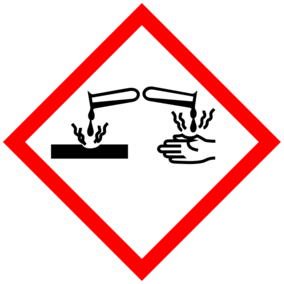Difference between revisions of "Aqua regia"
(→Disposal) |
|||
| (5 intermediate revisions by the same user not shown) | |||
| Line 1: | Line 1: | ||
| − | '''Aqua regia''' (Latin "'''royal water'''") also known as '''aqua regis''' ("'''king's water'''"), or '''nitro-hydrochloric acid''' is a highly corrosive fuming mixture of [[Nitric acid|nitric]] and [[ | + | '''Aqua regia''' (Latin "'''royal water'''") also known as '''aqua regis''' ("'''king's water'''"), or '''nitro-hydrochloric acid''' is a highly corrosive fuming mixture of [[Nitric acid|nitric]] and [[hydrochloric acid]]s, optimally in a volume ratio of 1:3. It is most commonly known as the mixture required to dissolve [[gold]]. |
==Properties== | ==Properties== | ||
| − | Aqua regia is a fuming red-yellow liquid at standard conditions. | + | Aqua regia is a fuming red-yellow liquid at standard conditions, with a strong irritant smell. |
| − | It is capable of reacting with [[gold]], [[platinum]] and [[palladium]], forming [[chloroauric acid]], [[chloroplatinic acid]] and [[palladium(II) chloride]] respectively. Because of this ability, aqua regia is used in the gold and platinum refining processes. The other "noble metals", [[ruthenium]], [[rhodium]], [[iridium]], and [[osmium]], are not reactive with aqua regia, though ruthenium will dissolve in the presence of oxygen and rhodium may but must be in a very finely | + | It is capable of reacting with [[gold]], [[platinum]] and [[palladium]], forming [[chloroauric acid]], [[chloroplatinic acid]] and [[palladium(II) chloride]] respectively. Because of this ability, aqua regia is used in the gold and platinum refining processes. The other "noble metals", [[ruthenium]], [[rhodium]], [[iridium]], and [[osmium]], are not reactive with aqua regia, though ruthenium will dissolve in the presence of oxygen and rhodium may, but must be in a very finely powdered form. [[Titanium]], [[tantalum]], [[niobium]], [[hafnium]], [[tungsten]], [[silver]] do not react as well. |
Aqua regia solutions are sometimes used in laboratories to remove hard to clean organic compounds from glassware, but only when the said compounds are in trace amounts. Aqua regia will react extremely violent with organic compounds in sufficient quantities, sometimes with explosive results. | Aqua regia solutions are sometimes used in laboratories to remove hard to clean organic compounds from glassware, but only when the said compounds are in trace amounts. Aqua regia will react extremely violent with organic compounds in sufficient quantities, sometimes with explosive results. | ||
| Line 16: | Line 16: | ||
*Dissolving gold | *Dissolving gold | ||
*Cleaning glassware | *Cleaning glassware | ||
| + | *Make [[nitrosyl chloride]] | ||
==Hazards and safety tips== | ==Hazards and safety tips== | ||
| Line 21: | Line 22: | ||
===Disposal=== | ===Disposal=== | ||
| − | Neutralize the solution after use with a basic neutralizing agent, such as [[sodium bicarbonate]] or calcium hydroxide. | + | Aqua regia must be first strongly diluted in water, preferably in a 1:10 ratio, by slowly adding the aqua regia dropwise in water, outside or in a fume hood. Neutralize the diluted solution after use with a basic neutralizing agent, such as [[sodium carbonate]]/[[sodium bicarbonate|bicarbonate]] or [[calcium hydroxide]]. |
==References== | ==References== | ||
| Line 36: | Line 37: | ||
[[Category:PCB etchants]] | [[Category:PCB etchants]] | ||
[[Category:Corrosive chemicals]] | [[Category:Corrosive chemicals]] | ||
| + | [[Category:Things that should NOT be messed with except by professionals]] | ||
Latest revision as of 19:16, 12 March 2021
Aqua regia (Latin "royal water") also known as aqua regis ("king's water"), or nitro-hydrochloric acid is a highly corrosive fuming mixture of nitric and hydrochloric acids, optimally in a volume ratio of 1:3. It is most commonly known as the mixture required to dissolve gold.
Contents
Properties
Aqua regia is a fuming red-yellow liquid at standard conditions, with a strong irritant smell.
It is capable of reacting with gold, platinum and palladium, forming chloroauric acid, chloroplatinic acid and palladium(II) chloride respectively. Because of this ability, aqua regia is used in the gold and platinum refining processes. The other "noble metals", ruthenium, rhodium, iridium, and osmium, are not reactive with aqua regia, though ruthenium will dissolve in the presence of oxygen and rhodium may, but must be in a very finely powdered form. Titanium, tantalum, niobium, hafnium, tungsten, silver do not react as well.
Aqua regia solutions are sometimes used in laboratories to remove hard to clean organic compounds from glassware, but only when the said compounds are in trace amounts. Aqua regia will react extremely violent with organic compounds in sufficient quantities, sometimes with explosive results.
Preparation
Aqua regia can be prepared by starting with a volume of concentrated hydrochloric acid and adding one third of the same volume of concentrated nitric acid, which should be done in a fume hood.[1]
By adding concentrated hydrochloric acid to a nitrate solution, the reaction yields nitrogen dioxide which dissolves in water to give nitric acid. This mixture is known as "poor man's aqua regia", as while it can dissolve gold, it's of lower quality than the original formula.
Projects
- Dissolving gold
- Cleaning glassware
- Make nitrosyl chloride
Hazards and safety tips
Never store aqua regia solutions! Over time it will oxidize and decompose to form toxic nitrosyl chloride, nitrogen dioxide and chlorine gases. Always mix the solution in a fume hood with the sash between you and the solution. Wearing a lab coat, appropriate gloves, splash goggles and/or a face shield is mandatory.Disposal
Aqua regia must be first strongly diluted in water, preferably in a 1:10 ratio, by slowly adding the aqua regia dropwise in water, outside or in a fume hood. Neutralize the diluted solution after use with a basic neutralizing agent, such as sodium carbonate/bicarbonate or calcium hydroxide.
